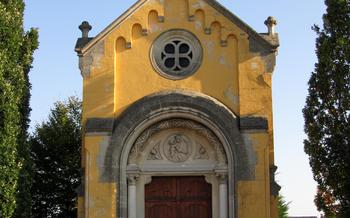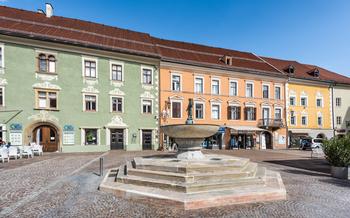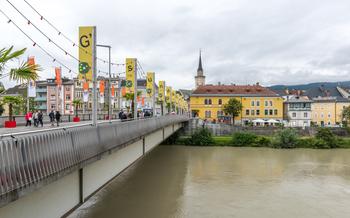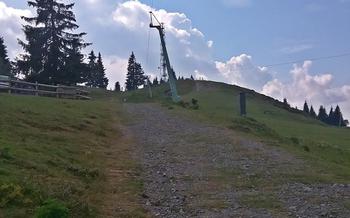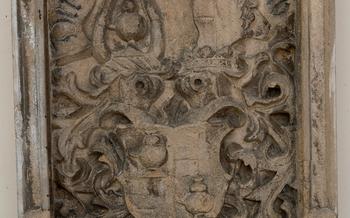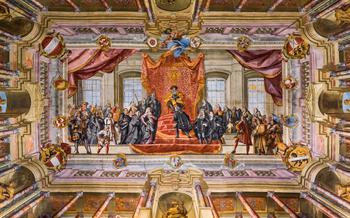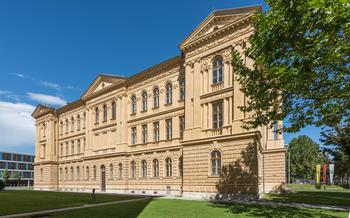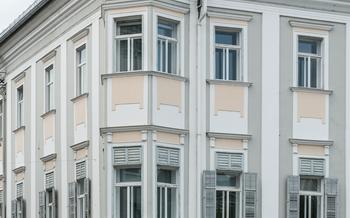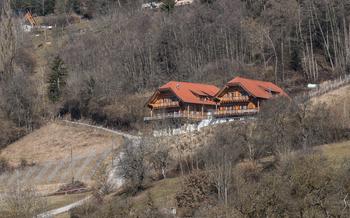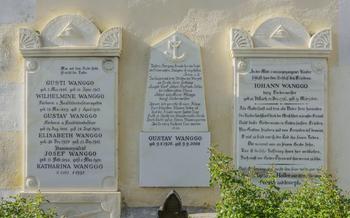
Bergbaumuseum Klagenfurt
- Bergbaumuseum Klagenfurt: A Journey into the Depths of Mining History
- Exploring the Museum's Exhibits: A Treasure Trove of Mining Artifacts
- The Fascinating World of Mining: Behind-the-Scenes Einblicke
- Witnessing the Ingenuity of Miners: The Mining Machinery
- Unearthing Hidden Treasures: The Mineral Collection
- Interactive Learning for Curious Minds: Educational Programs
- Preserving Heritage Through Restoration: The Museum's Role
- A Culinary Journey: Tasting Regional Delights
- Unforgettable Souvenirs: A Piece of Mining History
- Events and Exhibitions: Celebrating Mining Culture
- Accessibility for All: Ensuring an Inclusive Experience
- Practical Information: Planning Your Visit
- Photography and Social Media: Sharing the Experience
- Insider Tip: Hidden Gems to Discover
Bergbaumuseum Klagenfurt: A Journey into the Depths of Mining History
Enrich your understanding of mining heritage at the Bergbaumuseum Klagenfurt, a captivating museum nestled in the heart of Carinthia, Austria. Since its inception in 1972, the museum has been dedicated to preserving and showcasing the region's rich mining history. Here, visitors embark on a subterranean adventure, delving into the fascinating world of miners and their remarkable contributions to society.
Conveniently located in the city of Klagenfurt am Wörthersee, the museum is easily accessible by public transportation or car. Its central position makes it an ideal starting point for exploring the region's mining legacy. The Bergbaumuseum Klagenfurt stands as a testament to the significance of mining in shaping Carinthia's cultural and economic landscape. Its comprehensive exhibits, interactive displays, and educational programs offer a unique and immersive experience for visitors of all ages.
Beyond its historical significance, the museum's unique features set it apart from other mining museums. It boasts a diverse collection of mining artifacts, machinery, and minerals, providing a comprehensive overview of the region's mining industry. Interactive exhibits bring mining history to life, allowing visitors to experience the challenges and triumphs of miners firsthand. The Bergbaumuseum Klagenfurt is a true gem, offering an unforgettable journey into the depths of mining heritage.
Exploring the Museum's Exhibits: A Treasure Trove of Mining Artifacts
The Bergbaumuseum Klagenfurt houses a diverse collection of exhibits that vividly showcase the rich mining history of the region. Visitors can embark on a journey through time as they explore displays of mining tools, machinery, and minerals, gaining insights into the lives and work of miners from centuries past.
Among the highlights of the collection are meticulously preserved mining tools, such as picks, shovels, and lamps, which offer a tangible connection to the arduous labor of miners. These tools, each with its own unique purpose, tell stories of the challenges and triumphs faced by those who worked in the mines.
The museum also features an impressive array of mining machinery, from hand-operated drills to massive steam-powered engines. These machines revolutionized mining operations, enabling miners to extract ores and minerals more efficiently and safely. Visitors can marvel at the ingenuity and engineering prowess behind these remarkable inventions.
Interactive displays add an engaging dimension to the museum's exhibits. Visitors can operate replicas of mining tools, simulating the experience of working in a mine. These hands-on activities bring mining history to life, allowing visitors to gain a deeper appreciation for the skills and perseverance of miners.
The Bergbaumuseum Klagenfurt offers an educational experience suitable for visitors of all ages. Whether you're a history buff, a science enthusiast, or simply curious about the world beneath our feet, the museum's exhibits provide a wealth of knowledge and insights into the fascinating world of mining.
The Fascinating World of Mining: Behind-the-Scenes Einblicke
The Bergbaumuseum Klagenfurt unveils the captivating world of mining, transporting visitors back in time to experience the challenges and triumphs of miners. Step into the shoes of these hard-working individuals and gain insights into their daily lives, the risks they faced, and the techniques they employed to extract valuable resources from the depths of the earth.
Through interactive displays and multimedia presentations, the museum brings the history of mining to life. Witness the evolution of mining technology, from simple hand tools to sophisticated machinery that revolutionized the industry. Learn about the geological formations that led to the creation of mineral deposits and the processes involved in extracting these treasures.
Former miners share their personal anecdotes and stories, offering a glimpse into the camaraderie, hardships, and triumphs that shaped their lives. Their firsthand accounts provide a deeply personal perspective on the mining world, allowing visitors to connect with the human side of this fascinating industry.
Witnessing the Ingenuity of Miners: The Mining Machinery
The Bergbaumuseum Klagenfurt houses an impressive collection of mining machinery and equipment that showcases the ingenuity and technological advancements that have shaped the mining industry. Visitors can marvel at the sheer size and complexity of these machines, which were once essential tools for miners.
Displayed prominently in the museum are replicas of mining tools and machinery that visitors can interact with, providing a hands-on experience of the challenges and techniques involved in mining. These interactive exhibits allow visitors to operate replicas of mining tools, such as picks, shovels, and drills, giving them a sense of the physical effort and skill required in mining operations.
The museum also features a section dedicated to the evolution of mining technology. Multimedia presentations and interactive displays illustrate the progression from manual labor to the use of sophisticated machinery, highlighting the impact of technological advancements on mining efficiency and safety.
Personal anecdotes and stories from former miners add a human element to the museum's exhibits. Visitors can learn about the challenges and triumphs of miners, gaining insights into the lives of those who worked in these demanding conditions. These stories bring to life the hardships and camaraderie that miners experienced, providing a deeper understanding of their contributions to the region's mining legacy.
Unearthing Hidden Treasures: The Mineral Collection
The Bergbaumuseum Klagenfurt boasts an extensive collection of minerals and gemstones from the region, offering a glimpse into the geological wonders that lie beneath the surface of Carinthia. Stunning displays showcase the beauty and diversity of minerals, from shimmering crystals to colorful gemstones. Visitors can marvel at the intricate formations and learn about the geological processes that led to their creation. The museum also highlights the importance of minerals in modern-day life and technology, explaining how they are used in everything from electronics to medicine. This collection is a testament to the region's rich mineral heritage and provides a fascinating insight into the world of geology.
Interactive Learning for Curious Minds: Educational Programs
The Bergbaumuseum Klagenfurt offers a wide range of educational programs and workshops designed to engage visitors of all ages in the fascinating world of mining. Children and adults alike can participate in hands-on activities that allow them to experience mining processes firsthand and gain a deeper understanding of the history and significance of mining in the region.
Guided tours led by knowledgeable museum staff provide an immersive and informative experience, as visitors are taken on a journey through the museum's exhibits and given insights into the lives and challenges of miners. These tours are tailored to different age groups and interests, ensuring that everyone can learn and enjoy at their own pace.
For school groups and families, the museum offers customized educational programs that align with school curricula and provide a unique opportunity for students to learn about mining history and geology in a fun and interactive way. These programs can be tailored to specific needs and interests, making them a valuable resource for educators and parents alike.
Through its educational initiatives, the Bergbaumuseum Klagenfurt plays a vital role in preserving and promoting mining heritage while inspiring future generations to explore the wonders of science, technology, and the natural world.
Preserving Heritage Through Restoration: The Museum's Role
The Bergbaumuseum Klagenfurt is not just a repository of mining artifacts; it is also an active participant in preserving the region's mining heritage. The museum's dedicated team works tirelessly to restore and maintain mining equipment and artifacts, ensuring that these relics of the past remain accessible to future generations. Through meticulous restoration efforts, the museum brings to life the stories of the miners and the challenges they faced, preserving their legacy for posterity.
In addition to restoring artifacts, the museum collaborates closely with local communities to document mining traditions and practices. These collaborations ensure that the knowledge and skills of past miners are not lost but are passed on to future generations. The museum's commitment to cultural preservation extends beyond its walls, as it actively participates in research projects and educational initiatives aimed at promoting the understanding and appreciation of the region's mining heritage.
By preserving and promoting the region's mining legacy, the Bergbaumuseum Klagenfurt plays a crucial role in safeguarding a vital part of Carinthian culture. Through its restoration efforts, community collaborations, and educational initiatives, the museum ensures that the stories and traditions of the miners live on, inspiring future generations to learn from the past and appreciate the contributions of those who shaped the region's industrial heritage.
A Culinary Journey: Tasting Regional Delights
Immerse yourself in the culinary delights of Carinthia, a region deeply influenced by its mining heritage. Traditional dishes, passed down through generations, reflect the resourcefulness and resilience of the mining communities. Savor the iconic Kärntner Kasnudeln, delicate pasta pockets filled with a savory mixture of cheese, potatoes, and herbs. Indulge in Reindling, a sweet pastry swirled with cinnamon, nuts, and raisins, a testament to the region's sweet tooth.
Venturing beyond the museum, explore local restaurants and Gasthöfe that celebrate Carinthian cuisine. These establishments, often family-run, offer a warm and welcoming atmosphere, where you can engage with the locals and learn about their culinary traditions. Ask for recommendations on regional specialties and pair your meal with a glass of local wine or beer.
Supporting local businesses that uphold these culinary traditions is not only a delicious experience but also a way to preserve the cultural heritage of the region. Join the culinary journey and savor the flavors that tell the story of Carinthia's mining past.
Unforgettable Souvenirs: A Piece of Mining History
The Bergbaumuseum Klagenfurt offers a unique opportunity to take home a piece of mining history through its well-stocked souvenir shop. Here, visitors can find a wide variety of mining-themed items, from traditional tools and equipment to books, postcards, and replicas of mining machinery. These souvenirs make for excellent gifts and collectibles, serving as a reminder of your visit and the region's rich mining heritage.
One of the most popular souvenirs is the traditional miner's lamp, a symbol of the hard work and dedication of the miners who worked in the region's mines. Visitors can also purchase replicas of mining tools, such as picks, shovels, and hammers, which provide a tangible connection to the mining history of the region.
For those interested in learning more about the history of mining in Carinthia, the museum shop offers a selection of books and publications that delve into the topic in depth. These books provide insights into the lives of miners, the techniques they used, and the challenges they faced.
Postcards and other small items are also available, offering visitors a way to share their museum experience with friends and family. By purchasing souvenirs from the Bergbaumuseum Klagenfurt, visitors not only take home a memento of their visit but also contribute to the preservation efforts of the museum, ensuring that this important part of Carinthian history is kept alive for future generations.
Events and Exhibitions: Celebrating Mining Culture
The Bergbaumuseum Klagenfurt not only preserves and presents the region's mining heritage through its exhibits but also organizes temporary exhibitions and special events that celebrate mining culture. These events provide visitors with an opportunity to delve deeper into various aspects of mining and its impact on the region.
Temporary exhibitions often focus on specific themes related to mining history, mining techniques, or the lives of miners. These exhibitions showcase rare artifacts, documents, and photographs that provide a unique perspective on the mining past. Visitors can learn about the challenges faced by miners, the technological advancements that revolutionized the industry, and the cultural traditions associated with mining.
Special events include mining-themed workshops, demonstrations, lectures, and guided tours. These events are a great way to engage with experts, enthusiasts, and former miners who share their knowledge and experiences firsthand. Visitors can participate in hands-on activities, such as panning for gold or operating replicas of mining tools, which bring mining history to life.
By hosting these events, the Bergbaumuseum Klagenfurt aims to promote the museum and engage the community. It provides a platform for discussions, learning, and cultural exchange, ensuring that the region's mining heritage remains alive and relevant for future generations.
To make the most of your visit, check the museum's website or social media pages for information on upcoming events and exhibitions. Plan your visit accordingly to coincide with an event that interests you, and don't miss the opportunity to participate in these enriching experiences.
Accessibility for All: Ensuring an Inclusive Experience
The Bergbaumuseum Klagenfurt is committed to creating an inclusive and welcoming environment for all visitors, regardless of their abilities. The museum features a range of accessibility features to ensure that everyone can enjoy and learn from its exhibits.
Wheelchair users and visitors with limited mobility can easily navigate the museum's spacious galleries and exhibits thanks to ramps and elevators. These features allow visitors to move around the museum independently and access all levels of the building.
In addition, the museum offers guided tours and educational programs that are adapted for visitors with special needs. These tours and programs are designed to provide a comprehensive and engaging experience for all participants, regardless of their abilities.
The museum staff is always happy to assist visitors with disabilities and provide any additional support that may be needed. By creating an accessible and inclusive environment, the Bergbaumuseum Klagenfurt ensures that everyone has the opportunity to explore the fascinating world of mining history.
Practical Information: Planning Your Visit
Before embarking on your journey into the depths of mining history at the Bergbaumuseum Klagenfurt, it's essential to plan your visit to ensure a smooth and enjoyable experience. The museum is open from Tuesday to Sunday, with varying hours depending on the season. Admission fees are reasonable, with discounts available for children, students, and seniors. Guided tours are offered in German and English, and advanced booking is recommended to secure your spot.
Getting to the museum is a breeze, whether you choose public transportation or your own car. Public buses stop right outside the museum, making it easily accessible from various parts of the city. For those driving, ample parking is available nearby, with designated areas for disabled visitors. Parking fees are minimal, and the museum staff is always on hand to assist with directions and parking information.
To enhance your visit, consider joining a guided tour led by knowledgeable museum staff. These tours provide valuable insights into the exhibits, mining history, and the region's mining legacy. Tours are available in various languages, including English, German, and Italian, and can be booked in advance through the museum's website or by contacting the museum directly.
Photography and Social Media: Sharing the Experience
Capture the essence of your visit to the Bergbaumuseum Klagenfurt through the lens of your camera. Feel free to take photos and videos inside the museum, while respecting the guidelines in place to preserve the exhibits. Share your mining adventure on social media, using relevant hashtags and tagging the museum's official accounts. By doing so, you become part of a vibrant community of mining enthusiasts and contribute to promoting the museum's incredible collection. Additionally, the museum encourages visitors to share their own mining-related photos and stories, creating a collective tapestry of mining heritage. Share your unique perspective and inspire others to delve into the fascinating world of mining history.
Insider Tip: Hidden Gems to Discover
Beyond the main exhibits, the Bergbaumuseum Klagenfurt holds a few hidden gems that offer a unique perspective on mining history. One such gem is the "Miner's Chapel," a small, secluded room that recreates the underground chapels where miners would pray for safety and guidance before descending into the depths. The chapel features a replica of a wooden altar, candles, and mining tools, creating a solemn and evocative atmosphere that transports visitors back in time.
Another hidden gem is the "Miner's Garden," a tranquil outdoor space located behind the museum. The garden features a variety of plants and flowers that were commonly found in the gardens of miners' cottages. Visitors can stroll through the garden, enjoying the peace and serenity, and imagining the lives of the miners who once tended to these plants after a long day of work underground.
